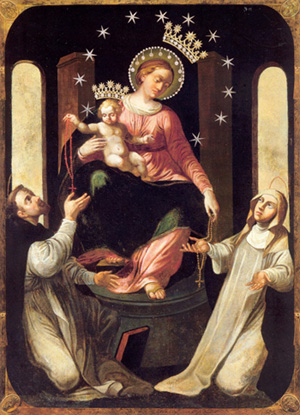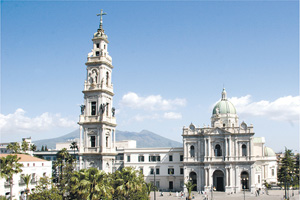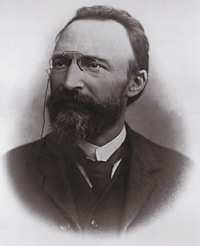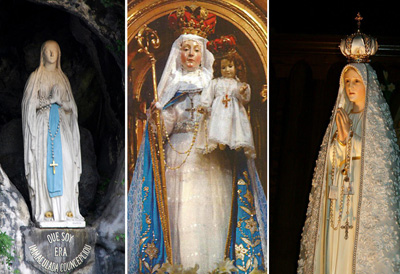Feast Days of Our Lady
 |
 |
 |
 |
 |
 |
 |
Our Lady of the Rosary of Pompeii - May 7
Biographical selection:
This devotion dates from the year 1875. In that year a disconsolate sinner – a lawyer named Bartolo Longo – was walking in the Valley of Pompeii near Naples in search of peace for his anguished soul.
 Suddenly an interior voice spoke to him: “If you want to find peace, spread devotion to the Rosary for this is the way of sure salvation.” Bartolo, touched by grace, resolved then and there to obey that counsel.
Suddenly an interior voice spoke to him: “If you want to find peace, spread devotion to the Rosary for this is the way of sure salvation.” Bartolo, touched by grace, resolved then and there to obey that counsel.
The number of people who took part in the public recitation of the Rosary he promoted every afternoon grew, and he went to Naples to find a suitable picture of Our Lady to feed the enthusiasm. There he providentially found and purchased a beautiful picture representing the Virgin of the Rosary with St. Dominic and St. Catalina.
He enshrined it in a chapel in that Valley and the devotion to the Rosary grew there as well as surrounding regions. The miracles multiplied in the small chapel and thousands of pilgrims came to touch and pray before the picture of Our Lady of Pompeii.
As the years passed, a great sanctuary was built and the Valley was renamed the Metropolis of the Rosary and the invocation to the Virgin as Our Lady of Pompeii spread around the world.
Comments of Prof. Plinio:
A coincidence here is very beautiful. One of the splendors and beauties of Rome is to see how Paganism was buried and conquered by the Church. The ancient and very powerful Paganism left those colossal monuments and ruins, died and became entirely fossilized. But alongside those ruins and sometimes even using structures the Church built Catholic monuments. Paganism became a skeleton and the Church flourished there for 2,000 years.
 The same thing happened in the Valley of Pompeii. As you know, the city of Pompeii was completely destroyed in 79 AD when a nearby volcanoin the Mount Vesuvius erupted and buried it under lava and ash. The place became famous for its archeological research.
The same thing happened in the Valley of Pompeii. As you know, the city of Pompeii was completely destroyed in 79 AD when a nearby volcanoin the Mount Vesuvius erupted and buried it under lava and ash. The place became famous for its archeological research.
Then, in 1875, something happened in a valley in Pompeii that gave new fame to that deserted place. An old devotion reemerged among the Catholics there with an extraordinary life.
As you know, the devotion of the Rosary came from the time of St. Dominic, therefore, from the 12th and 13th centuries. This devotion became so common among the people that it grew old, so to speak. But Divine Providence worked new miracles to give it a new life and raise a new enthusiasm for it.
A famous lawyer, Bartolo Longo, was anguished and wandering through the Valley of Pompeii. He heard interiorly a voice from Heaven telling him to disseminate the Rosary and his anguish would leave him. He resolved to follow that counsel and, from this, a grandiose church was built that became one of the most important of Italy, the Pontifical Shrine of the Blessed Virgin of the Rosary of Pompeii.
 Italy is a country with many important sites of piety, but that church became one of its most famous. The devotion to Our Lady of the Rosary re-bloomed with an extraordinary success.
Italy is a country with many important sites of piety, but that church became one of its most famous. The devotion to Our Lady of the Rosary re-bloomed with an extraordinary success.
Here in São Paulo (Brazil), we also have a Church of Our Lady of the Rosary of Pompeii, which gave the name to the Pompeii neighborhood. Churches and shrines throughout Europe and the Americas took this name and spread the practice of the Rosary, showing the continuity and perpetuity of the devotions of the Church.
There is something else worthy of note: A characteristic of the devotion to the Rosary is that the faithful adhere to it by a sort of instinct, without knowing exactly why. Everyone who has Faith is favorable to the Rosary, everyone who has good spirit adheres to the Rosary, and no argumentation is necessary to induce Catholics to like the Rosary.
This instinct stems not from mimicry or imitation, but corresponds to a very high design of Providence, which wants those 15 mysteries of the lives of Our Lady and Our Lord to be meditated upon and prayed by all the faithful in that particular sequence. Our Lady wants this devotion following that sequence.
You can see how this instinct of piety works by the following fact: There are Rosaries that you have seen that are rings persons put on their fingers. On that ring are 10 protruding gears and one Cross. That wheel is turned five times around the finger to say one terço of the Rosary. A person can pray the Rosary in this way, a method that, I believe, even has indulgences.
But someone might be surprised if I were to say, “Let us pray the Rosary,” and then I were to pull that wheel from my pocket. He would find it strange; it how this instinct works.

 The devotion of the Rosary is linked to use an object Our Lady showed us when she requested us to pray it in various apparitions: She asked St. Dominic, St. Bernadette, the three shepherd children of Fatima and many others to use a Rosary similar to hers, that is, a long one when we pray. And even though the Holy See has granted indulgencies for the use of that small finger-wheel, the providential object to which the devotion of the Rosary is linked and is preferred by this instinct is the chain of 50 beads for the Hail Marys interspersed with five beads for the Our Fathers and preceded by five others – one for the Creed, three for the first Hail Marys and one for the Glory be. At the start of this series of beads hangs a Cross.
The devotion of the Rosary is linked to use an object Our Lady showed us when she requested us to pray it in various apparitions: She asked St. Dominic, St. Bernadette, the three shepherd children of Fatima and many others to use a Rosary similar to hers, that is, a long one when we pray. And even though the Holy See has granted indulgencies for the use of that small finger-wheel, the providential object to which the devotion of the Rosary is linked and is preferred by this instinct is the chain of 50 beads for the Hail Marys interspersed with five beads for the Our Fathers and preceded by five others – one for the Creed, three for the first Hail Marys and one for the Glory be. At the start of this series of beads hangs a Cross.
In an opposite sense, you can see the war the evil ones wage against the Rosary. Many religious orders used to have a Rosary hanging from the cincture of their habits. With Vatican Council II, the habits disappeared – and the Rosaries along with them. The progressivist Catholic who hates the habit also hates the Rosary; whoever hates the Rosary hates Our Lady, and whoever hates Our Lady is a child of darkness. This is how the opposite instinct works.
You see that this instinct of Catholic piety discerns subtleties and delicacies of feeling in these devotions, which are linked to the concrete object itself and can carry a blessing.
During an illness where I had to remain in bed at my home, a person with bad spirit came to visit me and saw some of you young men praying the Rosary in the entrance hall. He made this comment: “These young men are very dedicated and amiable, but they stand around in that hall praying those big Rosaries of one meter…” You see that the irritation this person had for the Rosary was such that he became angry with the large Rosary. This person would have been less upset with those young men if they had been using mini-rosaries.
I have seen very small Rosaries, but I do not like them very much.
Someone could ask: “So, is there an importance in the size?” I respond: “Yes, my dear friend, there is.” As much as persons of bad spirit are irritated by the large Rosary, we should be pleased by these large Rosaries and use them whenever possible.
Here we stress that neither the form of an object of piety is indifferent nor its size. They have a certain relation to the designs of Divine Providence; therefore, the good spirit of a man leads him to want these objects to be like this.
Things of piety are like this. Even a small fragment of it is important. It is like a living organism. If I were to say to a person: “Come here and give your finger so that I can cut just a small fragment from it,” he would jump back and say: “What! Cut a fragment of my finger?!”
Why this reaction? It is because since a finger is a living organism, even a small fragment of it has a great importance.
So it is with a small fragment of the devotion of Our Lady. It is immensely precious to us, who live from her mercy and hope our eternal salvation will come from her.


The Saint of the Day features highlights from the lives of saints based on comments made by the late Prof. Plinio Corrêa de Oliveira. Following the example of St. John Bosco who used to make similar talks for the boys of his College, each evening it was Prof. Plinio’s custom to make a short commentary on the lives of the next day’s saint in a meeting for youth in order to encourage them in the practice of virtue and love for the Catholic Church. TIA thought that its readers could profit from these valuable commentaries.
The texts of both the biographical data and the comments come from personal notes taken by Atila S. Guimarães from 1964 to 1995. Given the fact that the source is a personal notebook, it is possible that at times the biographic notes transcribed here will not rigorously follow the original text read by Prof. Plinio. The commentaries have also been adapted and translated for TIA’s site.
This devotion dates from the year 1875. In that year a disconsolate sinner – a lawyer named Bartolo Longo – was walking in the Valley of Pompeii near Naples in search of peace for his anguished soul.

The image of Our Lady of Pompeii
with St. Dominic & St. Catalina
The number of people who took part in the public recitation of the Rosary he promoted every afternoon grew, and he went to Naples to find a suitable picture of Our Lady to feed the enthusiasm. There he providentially found and purchased a beautiful picture representing the Virgin of the Rosary with St. Dominic and St. Catalina.
He enshrined it in a chapel in that Valley and the devotion to the Rosary grew there as well as surrounding regions. The miracles multiplied in the small chapel and thousands of pilgrims came to touch and pray before the picture of Our Lady of Pompeii.
As the years passed, a great sanctuary was built and the Valley was renamed the Metropolis of the Rosary and the invocation to the Virgin as Our Lady of Pompeii spread around the world.
Comments of Prof. Plinio:
A coincidence here is very beautiful. One of the splendors and beauties of Rome is to see how Paganism was buried and conquered by the Church. The ancient and very powerful Paganism left those colossal monuments and ruins, died and became entirely fossilized. But alongside those ruins and sometimes even using structures the Church built Catholic monuments. Paganism became a skeleton and the Church flourished there for 2,000 years.

The Pontifical Shrine of Our Lady of Pompeii
Then, in 1875, something happened in a valley in Pompeii that gave new fame to that deserted place. An old devotion reemerged among the Catholics there with an extraordinary life.
As you know, the devotion of the Rosary came from the time of St. Dominic, therefore, from the 12th and 13th centuries. This devotion became so common among the people that it grew old, so to speak. But Divine Providence worked new miracles to give it a new life and raise a new enthusiasm for it.
A famous lawyer, Bartolo Longo, was anguished and wandering through the Valley of Pompeii. He heard interiorly a voice from Heaven telling him to disseminate the Rosary and his anguish would leave him. He resolved to follow that counsel and, from this, a grandiose church was built that became one of the most important of Italy, the Pontifical Shrine of the Blessed Virgin of the Rosary of Pompeii.

Bartolo Longo
Here in São Paulo (Brazil), we also have a Church of Our Lady of the Rosary of Pompeii, which gave the name to the Pompeii neighborhood. Churches and shrines throughout Europe and the Americas took this name and spread the practice of the Rosary, showing the continuity and perpetuity of the devotions of the Church.
There is something else worthy of note: A characteristic of the devotion to the Rosary is that the faithful adhere to it by a sort of instinct, without knowing exactly why. Everyone who has Faith is favorable to the Rosary, everyone who has good spirit adheres to the Rosary, and no argumentation is necessary to induce Catholics to like the Rosary.
This instinct stems not from mimicry or imitation, but corresponds to a very high design of Providence, which wants those 15 mysteries of the lives of Our Lady and Our Lord to be meditated upon and prayed by all the faithful in that particular sequence. Our Lady wants this devotion following that sequence.
You can see how this instinct of piety works by the following fact: There are Rosaries that you have seen that are rings persons put on their fingers. On that ring are 10 protruding gears and one Cross. That wheel is turned five times around the finger to say one terço of the Rosary. A person can pray the Rosary in this way, a method that, I believe, even has indulgences.
But someone might be surprised if I were to say, “Let us pray the Rosary,” and then I were to pull that wheel from my pocket. He would find it strange; it how this instinct works.

In the apparitions Our Lady shows large Rosaries,
not a finger Rosary or a small one, below

In an opposite sense, you can see the war the evil ones wage against the Rosary. Many religious orders used to have a Rosary hanging from the cincture of their habits. With Vatican Council II, the habits disappeared – and the Rosaries along with them. The progressivist Catholic who hates the habit also hates the Rosary; whoever hates the Rosary hates Our Lady, and whoever hates Our Lady is a child of darkness. This is how the opposite instinct works.
You see that this instinct of Catholic piety discerns subtleties and delicacies of feeling in these devotions, which are linked to the concrete object itself and can carry a blessing.
During an illness where I had to remain in bed at my home, a person with bad spirit came to visit me and saw some of you young men praying the Rosary in the entrance hall. He made this comment: “These young men are very dedicated and amiable, but they stand around in that hall praying those big Rosaries of one meter…” You see that the irritation this person had for the Rosary was such that he became angry with the large Rosary. This person would have been less upset with those young men if they had been using mini-rosaries.
I have seen very small Rosaries, but I do not like them very much.
Someone could ask: “So, is there an importance in the size?” I respond: “Yes, my dear friend, there is.” As much as persons of bad spirit are irritated by the large Rosary, we should be pleased by these large Rosaries and use them whenever possible.
Here we stress that neither the form of an object of piety is indifferent nor its size. They have a certain relation to the designs of Divine Providence; therefore, the good spirit of a man leads him to want these objects to be like this.
Things of piety are like this. Even a small fragment of it is important. It is like a living organism. If I were to say to a person: “Come here and give your finger so that I can cut just a small fragment from it,” he would jump back and say: “What! Cut a fragment of my finger?!”
Why this reaction? It is because since a finger is a living organism, even a small fragment of it has a great importance.
So it is with a small fragment of the devotion of Our Lady. It is immensely precious to us, who live from her mercy and hope our eternal salvation will come from her.

 | |
|
|
The texts of both the biographical data and the comments come from personal notes taken by Atila S. Guimarães from 1964 to 1995. Given the fact that the source is a personal notebook, it is possible that at times the biographic notes transcribed here will not rigorously follow the original text read by Prof. Plinio. The commentaries have also been adapted and translated for TIA’s site.


